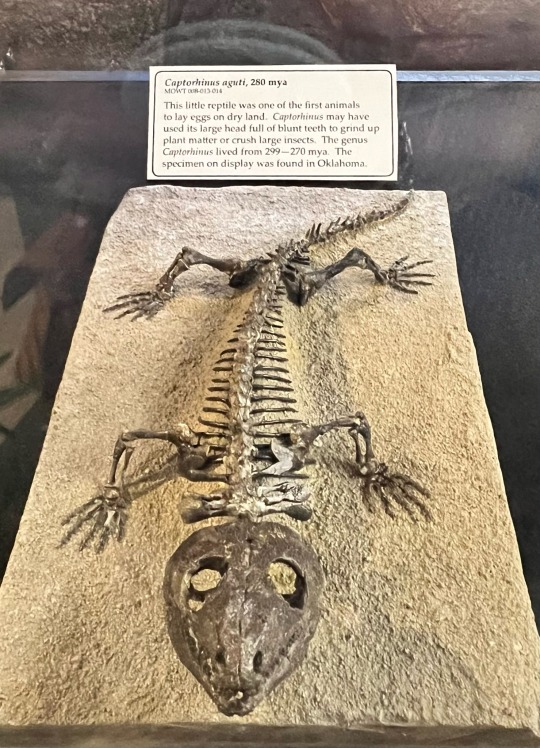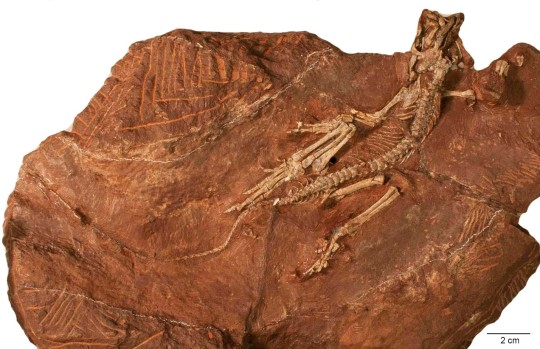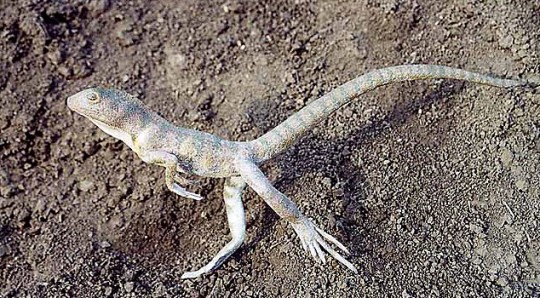#captorhinus
Text


Captorhinus skulls with pyrite and calcite crystal growth.
Captorhinus were anapsids from the Permian - meaning their skulls did not have the normal fenestration that diapsid reptiles or synapsid mammals have. Named for their hooked snout, these reptiles had a pineal(or "third") eye - a small photoreceptive spot on the top of the skull not seen in the pictures here.
414 notes
·
View notes
Text
352 notes
·
View notes
Text

Captorhinus aguti, 280 mya
Museum of World Treasures • Wichita, KS
#Captorhinus aguti#captorhinus#prehistory#paleontology#fossils#fossil#prehistoric life#reptile#ancient life#my pix
60 notes
·
View notes
Text
Paleozoic cave system preserves oldest-known evidence of amniote skin
Published 11th January 2024
The first record of a skin-cast fossil from the Paleozoic Era and the earliest known occurrence of epidermal integumentary structures within the infilled cave system of Richards Spur, Oklahoma. The preserved material provides insights into the evolution of skin during the transition from aquatic to fully terrestrial environments by early amniotes.

Articulated skeleton of Captorhinus aguti with preserved linear integumentary structures above the vertebral column, this structure is interpreted as skin

Three-dimensional skin cast and compression fossils from unknown amniotes

Lepospondyl, temnospondyl, and unknown tetrapod dermal scales
Source:
6 notes
·
View notes
Text
Un sistema di caverne risalente a 289 milioni di anni fa conserva la pelle fossile più antica che si conosca
La pelle fossile di Captorhinus aguti.
Un frammento di pelle fossile raccolto nel sistema di grotte calcaree Richards Spur in Oklahoma, negli Stati Uniti, è più antico di almeno 21 milioni di anni rispetto ai fossili di pelle precedentemente descritti.
La pelle fossile appena descritta apparteneva al Captorhinus aguti, una specie di rettile primitivo vissuto nel periodo Permiano, circa 289…

View On WordPress
0 notes
Text

Know Unknown Facts About Permian Reptile Fossils
Did you know that some Permian reptiles, like Captorhinus aguti, had four short, sturdy legs with five toes on each foot? Its limbs were well-suited for walking on land, but it is unlikely that it was a fast runner.? Or the Cacops had a large number of teeth arranged in rows along the edge of its jaw? The teeth were sharp and pointed, suggesting that it was a carnivore.Read More: https://www.fossilageminerals.com/
0 notes
Photo

Recently, a paper was published describing multiple specimens of Captorhinus, that show signs of a last ditch defense we see in some modern lizards; tail dropping. Unless you’re like my crested gecko, who showed up without a tail one day which never grew back, most lizards that practice this behavior are capable of regrowing their tails. But it generally isn’t perfect, and random mutations happen from time to time that lead to forked tails, or even in some isolated cases, a lizard having three tails! I explored that here with Captorhinus. Captorhinus and its relatives are reptiles that evolved before the lepidosaur, but I based his little hand wave off modern lizards.
#captorhinus#tail dropping#tail#tails#autotomy#caudal autotomy#reptile#reptilia#captorhinids#permian#early permian#paleoart#paleo#drawing#traditional#pencil#paleoblr#palaeoblr
12 notes
·
View notes
Text
The Bromacker Fossil Project Part VII: Eudibamus cursoris, the Original Two-legged Runner

Holotype specimen of Eudibamus cursoris, the most complete bolosaurid reptile known. Photo by the author, 2013.
Stuart Sumida discovered some small bones in the Bromacker quarry in 1993, the same year that the holotype skeleton of Diadectes absitus was found. Dave Berman told me that when Stuart showed them to him, he couldn’t see anything because they were so small. Upon closer examination, Dave, Stuart, and Thomas Martens identified them as those of the captorhinomorph reptile Thuringothyris mahlendorffae. Thomas’ wife Stefani, whose maiden name is Mahlendorff, discovered the first specimen in the Bromacker in 1982, and Thomas and a colleague named it in her honor in a 1991 publication.
The fossil was exposed in several pieces of rock, which Thomas shipped to Carnegie Museum of Natural History (CMNH) along with the large block of rock containing Diadectes. I didn’t prepare the specimen until several years later, as other projects, including the Diadectes, overshadowed it. Once I began working on it, though, Dave and I realized that it was not Thuringothyris. Indeed, we had no idea what type of animal it was, and our puzzlement grew as I exposed more of it. The identity wasn’t revealed until I had uncovered some very unusual, tiny teeth, which under the high magnification of the preparation microscope appeared to have a bulbous cusp towering over a basin. They looked vaguely familiar to me, but because I couldn’t immediately put a name on them, I rushed to get Dave from his office. Once Dave saw the teeth, he realized that the specimen was a new genus and species in the rare, enigmatic reptile group Bolosauridae.

Tiny teeth of a bolosaurid reptile, Bolosaurus striatus, in lateral (side; left) and occlusal (chewing surface; right) views. The specimen is in the CMNH Vertebrate Paleontology collection. Photos by Spencer Lucas (Research Associate, CMNH).
Until the discovery of Eudibamus cursoris, bolosaurids were represented in the fossil record by two genera, Bolosaurus and Belebey, which were based mainly on poorly preserved skull and fragmentary jaw fossils from Texas and Russia, respectively. Even though bolosaurids had been known since 1878, their relationship to other reptiles was not well understood. The nearly complete anatomy of Eudibamus allowed our team to determine that bolosaurids are the oldest member of the ancient group of reptiles called Parareptilia. This group has no living relatives, except possibly for turtles, a hypothesis that is highly debated by scientists.

Closeup of front and hind legs of Eudibamus. The hind leg, folded upon itself, is considerably longer than the front leg. Photo by the author, 2013.
When our study of the fossil began, we realized that Eudibamus was very different than other reptiles from that time. Proportions of the limbs and positions of the articulation surfaces on the upper and lower hind leg bones indicated that, in terms of posture, Eudibamus resembled a bow-legged human with a bad back instead of a typical sprawling reptile on four legs. It could stand and locomote on its hind legs in an upright posture (bipedal) with its legs held close together and in the same plane (parasagittal).
Dave was in constant phone communication with team member Dr. Robert Reisz (Professor, University of Toronto at Mississauga). One day Robert called Dave to ask if all the tail had been exposed, because he learned that modern lizards that are able to run bipedally have a long tail to help maintain their balance. The specimen was in Dave’s office and he immediately uncovered more of the tail and then let me finish the task. The tail was indeed very long and extended close to the edge of the block, which I had previously reduced in size. Additionally, we determined that the third, fourth, and fifth toes of the hind foot also were greatly elongated through lengthening of some of the individual toe bones, and that the first and second toes were extremely shortened by the reduction in size of individual toe bones. We hypothesized that when Eudibamus ran bipedally, it would rise on its toes, so that only the tips of the third, fourth, and fifth toes would contact the ground.

Drawing of the hind leg of Eudibamus cursoris (left) and the roughly contemporaneous reptile Captorhinus (right). Leg drawings are scaled to the same torso length of the whole animal. Illustrations of the animals are not to scale. Hind leg drawings are modified from Berman et al., 2000 and animal illustrations are from Wikimedia Commons.
Eudibamus occurred at least 60 million years before other bipedal, parasagittally-running reptiles appeared in the fossil record. This is reflected in its scientific name, which is derived from the Greek “eu,” meaning original or primitive, and “dibamos,” meaning on two legs. “Cursoris” is Latin, meaning runner. Examples of other reptiles using this locomotion mode are the dinosaurs Allosaurus fragilis and Tyrannosaurus rex, which you can view in CMNH’s Dinosaurs in Their Time exhibition.
So, what was the advantage of being able to run bipedally instead of running on all four legs? Lengthening the hind leg and foot would greatly increase stride length, especially if only the tips of the toes contacted the ground, which is an efficient way to increase speed. Eliminating arm to ground contact while running removes forelimbs from the path of the long-striding hind legs. The bulbous teeth and jaw structure of Eudibamusindicate that it was herbivorous. It seems likely, then, that Eudibamus used its ability to sprint to avoid becoming a tasty meal for a pursuing predator.

Peter Mildner (exhibit preparator at the Museum der Natur, Gotha) made a surprise visit to the Bromacker one afternoon to show us a model of Eudibamus cursoris he’d made. This image shows the model in the present day Bromacker quarry, part of the region it inhabited 290 million years ago. Photo by the author, 2006.
One of our laments is that a fossil trackway preserving Eudibamus walking quadrupedally and then switching to a bipedal gait has yet to be found.
Next time you are at CMNH, make sure you see the cast of the fossil skeleton and a model of Eudibamus that are exhibited in the Fossil Frontiers display case in CMNH’s Dinosaurs in Their Time exhibition. Stay tuned for my next post, which will feature the herbivorous mammal-like reptile Martensius bromackerensis.
For those of you who would like to learn more about Eudibamus, here is a link to the 2000 Science publication in which it was described: https://science.sciencemag.org/content/290/5493/969.
Amy Henrici is Collection Manager in the Section of Vertebrate Paleontology at Carnegie Museum of Natural History. Museum employees are encouraged to blog about their unique experiences and knowledge gained from working at the museum.
#Carnegie Museum of Natural History#Eudibamus cursoris#Reptiles#Fossils#Vertebrate Paleontology#Bromacker Fossil Project#Natural History
64 notes
·
View notes
Text
Ancient reptile Captorhinus could detach its tail to escape predator's grasp -- ScienceDaily
Visit Now - https://zeroviral.com/ancient-reptile-captorhinus-could-detach-its-tail-to-escape-predators-grasp-sciencedaily/
Ancient reptile Captorhinus could detach its tail to escape predator's grasp -- ScienceDaily
Imagine that you’re a voracious carnivore who sinks its teeth into the tail of a small reptile and anticipates a delicious lunch, when, in a flash, the reptile is gone and you are left holding a wiggling tail between your jaws.
A new study by the University of Toronto Mississauga research team led by Professor Robert Reisz and PhD student Aaron LeBlanc, published March 5 in the open source journal, Scientific Reports, shows how a group of small reptiles who lived 289 million years ago could detach their tails to escape the grasp of their would-be predators — the oldest known example of such behaviour. The reptiles, called Captorhinus, weighed less than 2 kilograms and were smaller than the predators of the time. They were abundant in terrestrial communities during the Early Permian period and are distant relatives of all the reptiles today.
As small omnivores and herbivores, Captorhinus and its relatives had to scrounge for food while avoiding being preyed upon by large meat-eating amphibians and ancient relatives of mammals. “One of the ways captorhinids could do this,” says first author LeBlanc, “was by having breakable tail vertebrae.” Like many present-day lizard species, such as skinks, that can detach their tails to escape or distract a predator, the middle of many tail vertebrae had cracks in them.
It is likely that these cracks acted like the perforated lines between two paper towel sheets, allowing vertebrae to break in half along planes of weakness. “If a predator grabbed hold of one of these reptiles, the vertebra would break at the crack and the tail would drop off, allowing the captorhinid to escape relatively unharmed,” says Reisz, a Distinguished Professor of Biology at the University of Toronto Mississauga.
The authors note that being the only reptiles with such an escape strategy may have been a key to their success, because they were the most common reptiles of their time, and by the end of the Permian period 251 million years ago, captorhinids had dispersed across the ancient supercontinent of Pangaea. This trait disappeared from the fossil record when Captorhinus died out; it re-evolved in lizards only 70 million years ago.
They were able to examine more than 70 tail vertebrae — both juveniles and adults — and partial tail skeletons with splits that ran through their vertebrae. They compared these skeletons to those of other reptilian relatives of captorhinids, but it appears that this ability is restricted to this family of reptiles in the Permian period.
Using various paleontological and histological techniques, the authors discovered that the cracks were features that formed naturally as the vertebrae were developing. Interestingly, the research team found that young captorhinids had well-formed cracks, while those in some adults tended to fuse up. This makes sense, since predation is much greater on young individuals and they need this ability to defend themselves.
This study was possible thanks to the treasure trove of fossils available at the cave deposits near Richards Spur, Oklahoma.
Story Source:
Materials provided by University of Toronto. Note: Content may be edited for style and length.
0 notes
Photo



Incredible, Permian Reptile (Captorhinus) Mass Mortality - Oklahoma
This is an incredible, Lower Permian, fossil reptile mass mortality block from the famous Richard's Spur Quarry in Oklahoma. It was found in a cave fissure fill deposit within the quarry.
There are three partially articulate Captorhinus aguti as well as parts of a Varanops skull which have been exposed through very careful preparation under microscope. Central in the block is a 2.7" Captorhinus skull which is laying on top of the jaws of a Varanops. There are two, vertebra columns to the side of the plate that would have gone to different animals, along with many disassociated bones.
For sale at: https://www.fossilera.com/fossils/incredible-permian-reptile-captorhinus-mass-mortality-oklahoma
47 notes
·
View notes
Photo









Permian Critters of the Field Museum
Eryops
Seymouria, Labidosaurus, Captorhinus, Cacops
Bradysaurus
Casea, Dimetrodon, Sphenacodon, Ophiacodon
Aulacephalodon, Jonkeria, Oudenodon
126 notes
·
View notes
Photo

Captorhinus was one of the first reptiles. Many scientists think we - as in all mammals - are descended from these little nuggets.
11 notes
·
View notes
Text
This ancient reptile could separate its tail to evade its predators
This ancient reptile could separate its tail to evade its predators

A new study has revealed that there was a prehistoric reptile living on Earth that could separate its tail to escape the predators. According to the new study, the reptile is an ancient lizard called captorhinus that lived more than 250 million years ago. The scientists of the latest analyzed the fossils of the lizard and discovered that this ancient group of lizard could detach their tails and…
View On WordPress
0 notes
Text
Differences between water and land turtles
Differences between water and land turtles
Want to know the differences between water and land turtles ? In this article by YourCatCareguide we focus on the details of the evolution of these fantastic reptiles over time.
In the Triassic, 260 million years ago, the tortoise’s ancestor, Captorhinus, first appeared to be the first reptile to have a shell that covered his chest, organs, and in addition covered his ribs. This made it possible…
View On WordPress
0 notes
Text
Ancient reptile Captorhinus could detach its tail to escape predator's grasp -- ScienceDaily
Ancient reptile Captorhinus could detach its tail to escape predator’s grasp — ScienceDaily
Imagine that you’re a voracious carnivore who sinks its teeth into the tail of a small reptile and anticipates a delicious lunch, when, in a flash, the reptile is gone and you are left holding a wiggling tail between your jaws.
A new study by the University of Toronto Mississauga research team led by Professor Robert Reisz and PhD student Aaron LeBlanc, published March 5 in the open source…
View On WordPress
0 notes
Link
Ancient reptile Captorhinus could detach its tail to escape predator's grasp https://archaeologynewsnetwork.blogspot.com/2018/03/ancient-reptile-captorhinus-could.html
0 notes